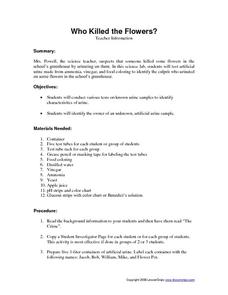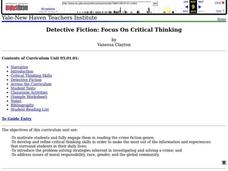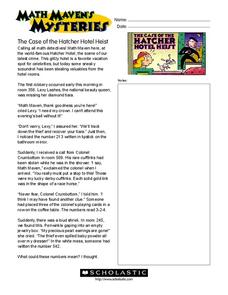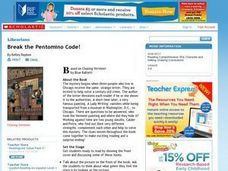University of Pennsylvania
Using Comic Strips to Teach Multiple Perspectives
Scholars view comics from two different perspectives; one paints the Alfred Dreyfus as innocent, while the other portrays the exact opposite. They solve the mystery of what happened by analyzing the source, working in groups, and...
Macmillan Education
The Tell-Tale Heart
Rather than who done it, the mystery literary detectives have to solve as they examine the evidence found in Edgar Allan Poe's famous "The Tell-Tale Heart" is why did he do it?
Curated OER
Write It, Read It, Solve It
Writers create an original mystery and have a chance to put it into movie format. The classic elements of a mystery must be present: the crime, the suspects, the motive, the solution and clues. Use iPhoto and Quicktime Movie to integrate...
Curated OER
Who Did It?
Students explore how forensic science is used in criminal investigations. They learn that for the next few days that are going to try to solve a crime that took place in the classroom. Students are given a story to read about the crime...
Lesson Snips
Who Killed the Flowers?
This could be really good, or it could be really bad! The crime to be solved is, "Who went pee in the flowerpot?" Given four imitation urine samples, young chemists or crime scene investigators perform pH, glucose, and turbidity...
Purdue University
The Case of the Pilfered Pin: A Measurement Inquiry Activity
Who pilfered the pin? Scholars practice measurement skills as they solve the mystery of a stolen pin. They measure length, temperature, and mass and determine which of select suspects committed the crime. During the STEM hands-on...
Curated OER
A Little Mystery and Intrigue in Writing Short Detective Stories
Learners read and analyze the twelve short stories in the novel "The Adventures of Sherlock Holmes." They create their own detective that has to solve a new kind of crime, and write and edit a short story with their original detective as...
Curated OER
Detective Fiction: Focus On Critical Thinking
Turn your 6th graders into detectives while growing their love of reading. Using critical thinking skills, they will be able to describe the five basic elements of detective fiction, read detective novels, make predictions, use the...
Curated OER
Case of the Missing Cookies
Pupils imagine they are a detective who has been asked to solve the theft of cookies from a jar in the student cafeteria. Students practice using the steps of the scientific method to solve the crime. Finally, pupils write a detailed...
Curated OER
Classic Short Stories- Locked Room Settings
Young scholars read the short story "The Problem of Cell 13" and examine the plot devices that build suspense. In this lesson students create their own short story using the same locked room setting.
Curated OER
Math Maven's Mysteries: Time for a Crime
In these math word problem worksheets, students help solve the mystery 'Time for a Crime.' Students read the story and use the ferry schedule to help track down the thief. Students circle the name of the guilty suspect.
Curated OER
JACK - CRIMINAL OR VICTIM?
Middle schoolers to use all levels of Bloom's taxonomy to look at the case of 'Jack and the Beanstalk' through the eyes of our present legal system. They analyze the story to determine if Jack was a criminal or a victim.
Curated OER
Math Maven's Mysteries
In these story problem worksheets, students read the story problem 'The Case of the Hatcher Hotel Heist' and use the information within the story to help them solve the problem. Students use addition and subtraction to find the next room...
Curated OER
Sherlock Holmes: Teaching English Through Detective Fiction
Students read examples of mysteries and detective fiction. With a focus on Sherlock Holmes, they are introduced to the techniques for reading properly. In groups, they define new vocabulary, make predictions and summarize the stories. ...
Curated OER
Mysteries in the Bag
Students write a story. In this creative writing lesson plan, students guess what is in various containers and open and discuss the contents. Students use one of the container contents to write a mystery story.
Curated OER
Math Maven's Mysteries
In these story problem worksheets, students read the story problem 'The Case of the Virtual Pet 2000' and use the information within the story to help them find which character had enough time to take the toy. Students use subtraction to...
Shmoop
ELA.CCSS.ELA-Literacy.RI.9-10.8
Your learners need to develop skills to argue effectively, and this comes by understanding the traditions that make claims valid, and what detracts from their effectiveness. Although this resource does not give advice on how to...
Curated OER
CSI Lesson Plans Can Turn Students Into Learning Detectives
Children learn to use the methods of good detection for solving a crime, and even analyzing literature.
Curated OER
Fingerprinting
Students list and describe the three types of fingerprint patterns. They list and describe three layers of fingerprints that can be made. They explain why we leave fingerprints.
Curated OER
Mystery Writing Lesson Plans
Introduce your class to the genre of mystery. Included is a vocabulary list, a rubric, and a sample mystery story called "Lethal Lesson." There are very limited directions on what to do with these resources, so you will need to plan some...
Curated OER
Police Use MySpace
Students interview law enforcement officials concerning their use of the Internet to catch criminals. They research how MySpace operates. They interview staff at MySpace and its uses. They write a news feature about a criminal case...
Curated OER
Forensic Detectives: Who Did It?
Students explore forensic science and its uses in criminal investigations. They solve a fictional crime by identifying and analyzing the fingerprints, strand of hair, and thread samples for evidence. After completing charts for each,...
Curated OER
Break the Pentomino Code!
Pupils read and analyze the book, Chasing Vermeer. They discuss the main story elements, analyze how pentominoes are important to the story, use a pentomino code to decipher a message, and create a secret code of their own.
Curated OER
Not So Snappy 4
In this order of operations (i.e., addition, subtraction, multiplication, division) learning exercise, students solve 4 word problems demonstrating their understanding of the concept.

























